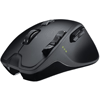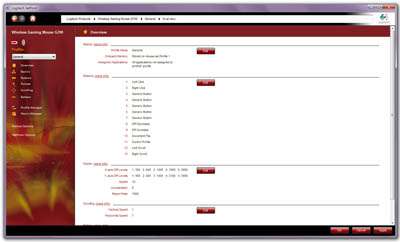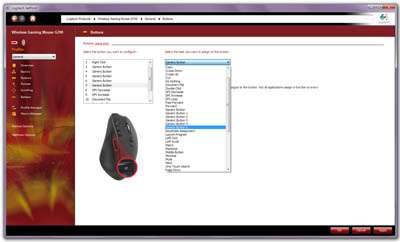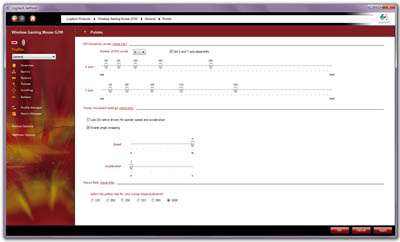- Qualcomm Launches Snapdragon 4 Gen 2 Mobile Platform
- AMD Launches Ryzen PRO 7000 Series Mobile & Desktop Platform
- Intel Launches Sleek Single-Slot Arc Pro A60 Workstation Graphics Card
- NVIDIA Announces Latest Ada Lovelace Additions: GeForce RTX 4060 Ti & RTX 4060
- Maxon Redshift With AMD Radeon GPU Rendering Support Now Available
Logitech G700 Wireless Gaming Mouse

Are you an avid gamer looking for a feature-rich and reliable gaming mouse that also happens to be wireless? Logitech’s G700 might be worth a look. At around $85, it’s not cheap, but it does offer a plethora of customizable buttons, the ability to go wired if the battery dies, and also supports a super-high 5700 DPI.
Page 3 – Software
Since this is Logitech, there is only one piece of software to download, the SetPoint software suite. This is an all encompassing suite that will adapt based on the peripherals installed. If you already have a Logitech device and SetPoint installed, it will automatically update itself to accommodate the new peripheral. Due to this being a G series or gaming peripheral, it gets its own user interface compared to other peripherals in Logitech’s range and has a special ‘Gaming’ version of the SetPoint suite.
It adds a second icon to the taskbar for some reason, but once open, you are greeted with a large, almost blank window to select which peripheral you want to edit.
After selecting the G700, we are presented with an overview, detailing all major settings at a glance.
Now some may be thinking, why is the interface so wide? That I can’t answer; –> –> this is what it defaults to and any adjustments made to window size are ignored when you reopen the interface.
Since this is a 13 button mouse, let’s see what button configurations there are.
A lot, that’s for sure. There are a few quirks however, for one, there are 6 entries in the list labeled ‘Generic Button’, 1-5 are default function buttons, making it possible to reverse buttons 4 and 5 for example as default actions when moving the mouse to another PC. The 6th generic is the hardware default for the assigned button. Other strange entries include ‘Do Nothing’ and ‘Unassigned’, both of which do the same, nothing (so why are there two?).
There is also a ‘One-Touch Search’ button that performs a search of the currently highlighted word(s) using whichever search engine and localization set in software, but try as I might, nothing happens.
This seems to be a very common problem which can only be fixed by removing the SetPoint software, renaming a system DLL and reinstalling the suite again – not exactly elegant. There are also certain button assignments that require the SetPoint software installed in order to function, but these are labelled as such so it should be easy to spot.
Moving on to pointer settings, things improve. One thing I love is the axis-independent DPI settings, extremely useful on widescreen displays, more so with multi-display setups. DPI levels can be set from 200 up to 5700 in 100 DPI intervals.
The usual Acceleration and Pointer Speed options are made available, as well as USB Poll Rate. After acquiring a helpful tool called ‘Direct Input Mouse Rate‘ (DIMR), I performed a number of tests to check if the mouse actually uses the full poll rate.
Well, this is when it gets a little tricky, the mouse itself is quite capable, the problem will likely come down to the USB controller. With two different PCs, the mouse achieved 2 different poll rates. The first PC could barely go above 500Hz, while the second hit an average of around 700-800Hz, peaking at about 980Hz.

For the most part, the difference between 500Hz and 1000Hz boils down to 1 millisecond (2ms vs. 1ms), so the chance of noticing any delay is negligible. The important thing to consider is that it exceeds 125Hz, which at 8ms, does become noticeable, especially when playing high frame-rate games as the mouse can seem jerky. There is a small difference between wired and wireless modes though, about 50-100Hz or 0.2ms, which is barely noticeable, so kudos for maintaining the performance even when wireless.
The Profile and Macro options are what make this mouse quite powerful. Profile switching can be set via either a button command on the mouse, or automatically with application detection. There is no limit to the number of profiles that can be made, but you may only save up to 5 on the mouse itself. Profile switching is pretty much instant, unlike certain Razer mice I have used, so you don’t have to wait around a few seconds for it to catch up.
The Macro manager is rather simple which can make it a little fiddly. Macros can be made with various inputs recorded, from both mouse and keyboard, including delays (useful for long commands). There doesn’t seem to be a limit to how long macros can be, which is very surprising.
There is a problem with editing as there is no mass selection, you must select and delete each event separately. There is also no way to build a macro without recording. Maybe in future versions, a more comprehensive macro tool set, akin to real macro software, could be used.
With the macro saved, you may assign it to any key on the mouse by going to the button menu and changing any key to ‘Macro’. This will show a drop-down menu to which any available macro can be selected. The most interesting part is that these macros are saved to the profile, and if the profile is saved on the mouse, you may use these macros on any computer. A case of configure once, use anywhere.
Now, multiply this out… there are 13 buttons, 12 of which can be assigned a macro function, 5 profiles worth of macros, that’s a total of 60 macros – should you be so inclined. There are no details on the G700’s total memory capacity, but judging by the configuration options, I’d say it was pretty extensive.
Support our efforts! With ad revenue at an all-time low for written websites, we're relying more than ever on reader support to help us continue putting so much effort into this type of content. You can support us by becoming a Patron, or by using our Amazon shopping affiliate links listed through our articles. Thanks for your support!








